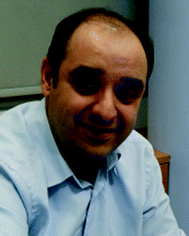Introduction to molecular systems for sensing
Stefania
Tanase
*a and
Anastasios J.
Tasiopoulos
*b
aVan ’t Hoff Institute for Molecular Sciences, University of Amsterdam, Science Park 904, 1098 XH Amsterdam, The Netherlands. E-mail: s.grecea@uva.nl
bDepartment of Chemistry, University of Cyprus, 1678 Nicosia, Cyprus. E-mail: atasio@ucy.ac.cy
In the past decade, the world has become increasingly aware of the importance to guarantee a sustainable and inclusive society for its citizens. This goes hand in hand with finding novel solutions to the challenges posed by current human activity. Across various fields, monitoring of the relevant parameters is essential to understand the processes involved, manage the risks and achieve improved functionality. Sensors are therefore key players in this game: they are ubiquitous and essential in ensuring technological performance. For example, the increased emission of volatile organic compounds is a major environmental concern and requires careful monitoring. Similarly, security and defence applications need effective portable monitoring, chemical weapons sensing, and water quality testing kits. Finally, health, energy and space exploration all require sensitive devices for temperature monitoring. As society demands better performances for a broader range of applications, new sensor devices are needed that are highly sensitive, small, robust and do not consume much power.
Chemical sensors transform chemical information into suitable signals; they can be optical, electrochemical and electrical, mass sensitive, magnetic, thermometric or other radiation-dependent sensors. Nowadays, research on chemical sensors is flourishing due to the exploitation of modern materials with exciting properties, such as metal organic frameworks (MOFs), covalent organic frameworks (COFs), inorganic nanowires, carbon nanotubes, graphene and a variety of other hybrid materials based on functionalized traditional substrates. Most of these materials allow tailoring of their structures and fine-tuning of their properties to enhance their selectivity and the detection limit for a variety of analytes, from ions to small and larger molecules in solution and the gas state.
This themed collection includes papers involving a variety of different types of materials, detection methods and analytes and highlights the potential of hybrid inorganic–organic materials for use in sensing applications. Five of the nine articles in this collection describe MOF sensors, two of them sensors built by layers of receptors on surfaces, one of them sensors made by functionalizing silica with organic ligands, and one deals with water soluble sensors. The analytes span a wide range as well. There are sensors employed for the detection of gases including CO2, NO2 and vapours of volatile organic compounds (VOCs), including dichloromethane and chloroform, and of liquids such as solutions of toxic metal ions (Cd2+ and Hg2+), allyl alcohol, anions and water. The detection of these chemical species was achieved by employing mainly optical and electrochemical methods. In fact, the variety of materials, analytes and detection methods considered in the articles in this collection shows the diversity and plurality of this research field. It appears that MOFs account for the lion's share of papers in this themed collection. This research preference can be explained by considering the advantages of MOFs over other chemical sensor materials. They are certainly of crystalline nature with a wealth of modifiable structural types and topology, permanent porosity and high stability, and have a broad range of tuneable properties, as discussed in detail in some of the papers in this collection.
As Guest Editors we wish to thank the authors for their valuable contributions to this themed collection, and hope readers enjoy these articles and learn from them as much as we have.
| This journal is © The Royal Society of Chemistry 2020 |


